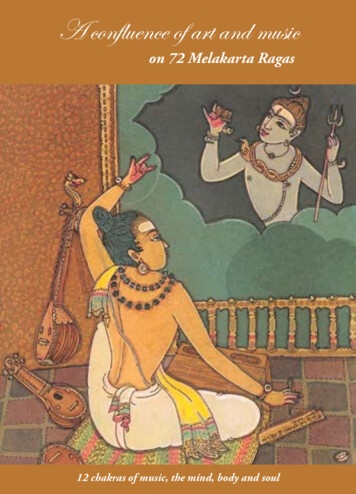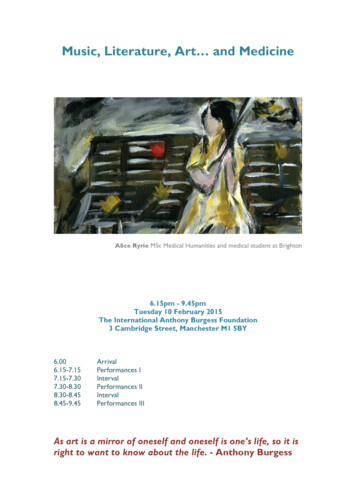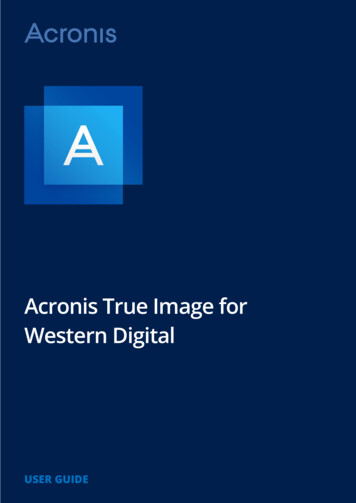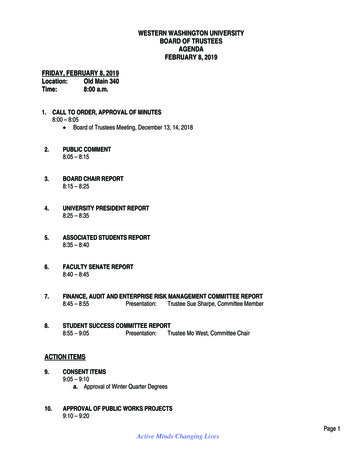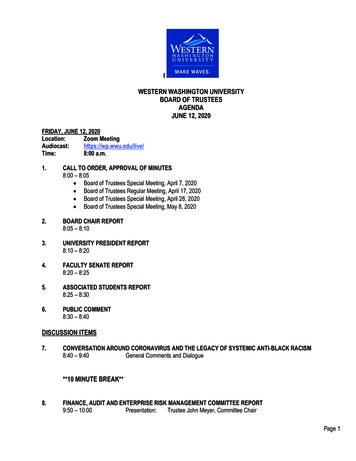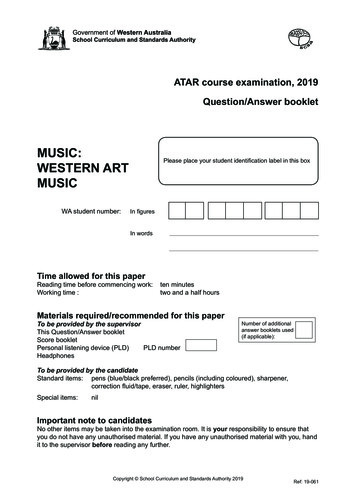
Transcription
ATAR course examination, 2019Question/Answer bookletMUSIC:WESTERN ARTMUSICWA student number:Please place your student identification label in this boxIn figuresIn wordsTime allowed for this paperReading time before commencing work:Working time :ten minutestwo and a half hoursMaterials required/recommended for this paperTo be provided by the supervisorThis Question/Answer bookletScore bookletPersonal listening device (PLD)PLD numberHeadphonesNumber of additionalanswer booklets used(if applicable):To be provided by the candidateStandard items: pens (blue/black preferred), pencils (including coloured), sharpener,correction fluid/tape, eraser, ruler, highlightersSpecial items:nilImportant note to candidatesNo other items may be taken into the examination room. It is your responsibility to ensure thatyou do not have any unauthorised material. If you have any unauthorised material with you, handit to the supervisor before reading any further.Copyright School Curriculum and Standards Authority 2019Ref: 19-061
WESTERN ART MUSIC2 Structure of the examinationThe Music ATAR course examination consists of a written component and a practical(performance and/or composition portfolio) component.Structure of this paperSectionNumber of Number ofSuggestedPercentageMarksquestions questions to working timeof writtenavailableavailable be answered(minutes)examinationSection OneAural and analysisSection TwoCultural and historical analysisPart A: AnalysisPart B: Short response(i) Compulsory area of study(ii) Non-compulsory area ofstudySection ThreeTheory and al100Instructions to candidates1.The rules for the conduct of the Western Australian external examinations are detailed inthe Year 12 Information Handbook 2019. Sitting this examination implies that you agreeto abide by these rules.2.Write your answers in this Question/Answer booklet.3.The examination is structured as follows:Section One: Common to all contexts and contains questions that require you to listenand respond to a selection of music excerpts.Section Two: Context-specific and comprises two parts: Part A and Part B.Part A: contains one question based on the compulsory area of study that requires you tolisten to a music excerpt and respond to the score provided.Part B(i): contains one question based on the compulsory area of study and score/s fromthe correlating designated works.Part B(ii): contains one question based on the non-compulsory area of study and thecorrelating designated works. If your response is based on the compulsory area of study,a 25% penalty will be applied.Section Three: Context-specific and contains theory questions and composition tasks.4.You must be careful to confine your answers to the specific questions asked and to followany instructions that are specific to a particular question.5.Supplementary pages for planning/continuing your answers to questions are provided atthe end of this Question/Answer booklet. If you use these pages to continue an answer,indicate at the original answer where the answer is continued, i.e. give the page number.6.The Score booklet is not to be handed in with your Question/Answer booklet.See next page
3 Section One: Aural and analysisWESTERN ART MUSIC36% (57 Marks)This section has six questions. Answer all questions. Write your answers in the spacesprovided.Supplementary pages for planning/continuing your answers to questions are provided at the endof this Question/Answer booklet. If you use these pages to continue an answer, indicate at theoriginal answer where the answer is continued, i.e. give the page number.Suggested working time: 50 minutes.Question 1: Interval recognition(a)(6 marks)Write the name of the two intervals indicated on the stave below.Listen to Track 1a(i)(ii)See next page(2 marks)
WESTERN ART MUSIC4 Question 1 (continued)(b)(i)Complete the melody below by writing the two missing notes on the stave, asindicated by the bracket.(2 marks)Listen to Track 1b(ii)Name the interval created by these two notes.(1 mark)(iii)State the modulation that has taken place by the end of the excerpt.(1 mark)See next page
5 WESTERN ART MUSICQuestion 2: Rhythmic dictation(12 marks)Listen to Track 2a and/or Track 2b and complete the following eight-bar dictation by providingbar lines, rhythm and rests as required to the given pitches. The excerpt may requirenotehead(s) to be changed to reflect a minim value. The correct rhythm for the first note of eachphrase is provided.* Denotes a restListen to Track 2aPrior to the commencement of the excerpt for the first time, three crotchets will be played on thewoodblock.The excerpt will be played as follows, with a 20-second pause between each playing: the complete excerpt played once the first phrase played twice the second phrase played twice the complete excerpt played twice.and/orListen to Track 2bPrior to the commencement of the excerpt, three crotchets will be played on the woodblock.The complete excerpt will be played once.See next page
WESTERN ART MUSIC6 Question 3: Discrepancies(5 marks)There are five errors in total in the following melody. There is one pitch error, one rhythm error(affecting one beat) and three errors in the form/structure, requiring signs/symbols to be addedto the score, to reflect how it is being played. Write the five required changes directly on thescore below. The first note is correct.Listen to Track 3Prior to the commencement of the melody, four crotchet beats will be heard.Question 4: Harmonic/chord progression(8 marks)Identify the eight chords indicated by (a) to (h) below, using Roman numerals or chord names inC major.Listen to Track 4The first chord of this excerpt is preceded by the tonic chord, followed by 4 crotchet beats on thewoodblock.(a)(b)(c)(d)(e)See next page(f)(g)(h)
7 WESTERN ART MUSICQuestion 5: Melodic dictation(15 marks)Listen to Track 5a and/or Track 5b and complete the following eight-bar melodic dictation byproviding the pitch and rhythm. The first note of each phrase is given.Listen to Track 5aPrior to the commencement of the excerpt for the first time, the tonic chord will be played on thepiano, and five quaver pulses will be played on the woodblock.The excerpt will be played as follows, with a 20-second pause between each playing: the complete excerpt played once the first phrase played twice the second phrase played twice the complete excerpt played twice.and/orListen to Track 5bPrior to the commencement of the excerpt, the tonic chord will be played on the piano, and fivequaver pulses will be played on the woodblock.The complete excerpt will be played once.See next page
WESTERN ART MUSIC8 Question 6: Aural analysis(11 marks)Listen to Track 6159(a)Write the missing time signature at the beginning of the excerpt.(b)Add stems and beams to the note heads in bars 1–4, to indicate the rhythmic groupingheard in the excerpt.(4 marks)(c)State where the cymbal first enters.Bar number:(d)(1 mark)(1 mark)First or second time:Provide three specific ways in which the composer has achieved contrast between theopening A section and the B section.(3 marks)One:Two:Three:(e)Identify two compositional devices heard in this excerpt.One:Two:End of Section OneSee next page(2 marks)
9 Section Two: Cultural and historical analysisWESTERN ART MUSIC34% (62 Marks)This section has two parts: Part A and Part B. You must answer all parts and write your answersin the spaces provided.Part A: contains one question based on the compulsory area of study that requires you to listento a music excerpt and respond to the score provided.Part B(i): contains one question based on the compulsory area of study and score/s from thecorrelating designated works.Part B(ii): contains one question based on a non-compulsory area of study and the correlatingdesignated works. You must answer part (a) and part (b). If your response is based on thecompulsory area of study, a 25% penalty will be applied.Supplementary pages for planning/continuing your answers to questions are provided at the endof this Question/Answer booklet. If you use these pages to continue an answer, indicate at theoriginal answer where the answer is continued, i.e. give the page number.Suggested working time: 55 minutes.Part A: Analysis11% (21 Marks)This part contains one question based on the compulsory area of study that requires you tolisten to a music excerpt and respond to the score provided.Question 7(21 marks)Listen to Track 7 WAMRefer to pages 26–28 of the Score booklet to answer this question.(a)Identify the era represented in this excerpt, providing three reasons to support yourchoice.(4 marks)Era:One:Two:Three:See next page
WESTERN ART MUSIC10 Question 7 (continued)(b)The keyboard instrument used in this recording is a fortepiano, the predecessor of themodern piano. The physical characteristics of the instrument are described in the tablebelow. Complete the table by outlining two physical characteristics of the harpsichordwhich preceded it and two physical characteristics of the piano which followed it.(4 marks)InstrumentHarpsichordDescription Fortepiano Pianowooden frame4–5 octave pitch rangehammers covered in leather rather than felt producing a lightertimbreshort keys, black and white keys reversedsometimes had pedals or stops (c)Identify two compositional devices evident between bars 1–5 in the winds, naming theinstrument/s involved.(4 marks)Compositional deviceInstrument/sSee next page
11 WESTERN ART MUSIC(d)Name the term to describe the harmonic progression between bars 14–19.(1 mark)(e)Identify an example of Alberti bass, providing bar numbers.(1 mark)Alberti bass instrument:Bar numbers:(f)How would the score direction zu 2 in the Fag. part in bar 20 be interpreted?(g)Describe the evolution of the cadenza in the overall form and structure of the concerto ineach of the following periods.(6 marks)Baroque:Classical:Romantic:See next page(1 mark)
WESTERN ART MUSIC12 Part B: Short response23% (41 Marks)Part B(i): Compulsory area of study11% (26 Marks)This part contains one question based on the compulsory area of study and score/s from thecorrelating designated works.Question 8(26 marks)Refer to pages 30–31 of the Score booklet to answer this question.(a)Identify the movement and section of the work represented in this excerpt.(2 marks)Movement:Section:(b)Identify the two themes evident in this excerpt, providing instrument/s and bar numbers.(6 marks)Theme(c)Instrument/sBar numbersName the four missing instruments indicated on the score.(4 marks)(i)(ii)(iii)(iv)(d)(i)Name and describe the performance technique evident in bar 4 (Trrr).See next page(2 marks)
13 WESTERN ART MUSIC(ii)Name the musical style whose influence is suggested by this performancetechnique.(1 mark)(iii)Outline two other ways this musical style is evident throughout the entire work.(2 marks)(e)Explain how the score direction 2ₒ in the Fag. part in bar 4 should be interpreted. (1 mark)(f)Provide four points to explain how Ravel creates both a sense of tonal ambiguity andharmonic stability in this section, referring to specific instruments.(4 marks)One:Two:Three:Four:See next page
WESTERN ART MUSIC14 Question 8 (continued)(g)Identify two compositional devices evident in bars 4–8.(2 marks)One:Two:(h)Outline two features of Ravel’s Piano Concerto in G that could be described asneo‑classical.(2 marks)One:Two:See next page
15 Part B(ii): Non-compulsory area of studyWESTERN ART MUSIC12% (15 Marks)This part contains one question based on the non-compulsory area of study and the correlatingdesignated works. You must answer part (a) and part (b).If your response is based on the compulsory area of study, a 25% penalty will be applied.Question 9(15 marks)Compare and contrast the use of rhythm in two of your designated works. Providespecific examples of the application of rhythm, drawn from your designated works.(7 marks)(a)See next page
WESTERN ART MUSIC16 Question 9 (continued)(b)‘Advances in technology can be empowering, progressive and enriching. History hasshown this across civilisations and societies’.Consider the statement above. Referring to one of your designated works andconsidering the time and place in which the work was written, discuss specific ways thecomposer embraced and incorporated technological advancements.(8 marks)End of Section TwoSee next page
17 Section Three: Theory and compositionWESTERN ART MUSIC30% (43 Marks)This section has three questions. Answer all questions. Write your answers in the spacesprovided.Supplementary pages for planning/continuing your answers to questions are provided at the endof this Question/Answer booklet. If you use these pages to continue an answer, indicate at theoriginal answer where the answer is continued, i.e. give the page number.Suggested working time: 45 minutes.See next page
WESTERN ART MUSIC18 Question 10: Visual score analysis(14 marks)Refer to the Score booklet on pages 32–33 to answer Questions 10, 11 and 12. (Bars 25–32have been left blank intentionally.)(a)(i)Name the opening key of this work.(1 mark)(ii)Identify the new key from bar 9 and state its relationship to the original key.(2 marks)Key:Relationship:(iii)Identify the cadence evident between bars 15 and 16, providing the cadencename and chords, using Roman numerals.(2 marks)Cadence:Chords:(b)Describe how the pianist performs the indication below the staff for the opening bar ofthis work.(2 marks)(c)Identify the following chords using Roman numerals, providing inversions where required.(3 marks)Bar 1, beat 2:Bar 5, beat 3:Bar 38, beat 1:(d)Describe two ways, other than key, the music has been varied at bar 9 to providecontrast.(2 marks)One:Two:See next page
(e)19 WESTERN ART MUSIC(i)Identify the form of this composition.(1 mark)(ii)Indicate the sections of this composition by using letter names and bar numbers.The first section has been provided.(1 mark)A Bar 1,See next page
WES
WESTERN ART MUSIC 8 See next page Question 6: Aural analysis (11 marks) Listen to Track 6 (a) Write the missing time signature at the beginning of the excerpt. (1 mark) (b) Add stems and beams to the note heads in bars 1–4, to indicate the rhythmic grouping heard in the excerpt. (4 marks) (c) State where the cymbal first enters. (1 mark)




